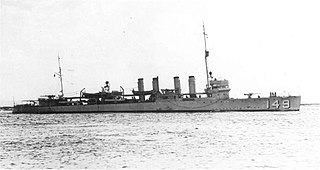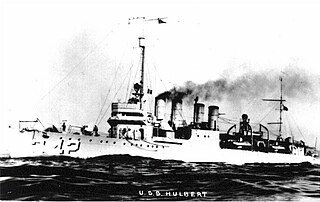
USS Dyess (DD/DDR-880), a Gearing-class destroyer, was a ship of the United States Navy named for Aquilla James Dyess (1909–1944). Dyess was awarded the Medal of Honor posthumously for his leadership of his battalion of Marines in the Battle of Kwajalein. The ship was laid down by Consolidated Steel Corporation at Orange, Texas on 17 August 1944, launched on 26 January 1945 and commissioned on 21 May 1945. The vessel spent the majority of her career patrolling the Mediterranean Sea with NATO forces. The ship was decommissioned on 27 January 1981 and sold to Greece the same year for spare parts.

The first USS Whipple (DD-15) was a Truxtun-class destroyer in the United States Navy, named for Abraham Whipple.

USS Barney (DD–149) was a Wickes-class destroyer in the United States Navy during World War II, later redesignated AG-113. She was the second ship named for Commodore Joshua Barney.

The third USS Lawrence (DD-8) was a Lawrence-class destroyer, which was a sub-class of Bainbridge-class destroyer, in the United States Navy. She was named for Captain James Lawrence.

The first USS Macdonough (DD-9) was a Lawrence-class destroyer, which was a sub-class of Bainbridge-class destroyer, in the United States Navy. She was named for Commodore Thomas Macdonough

The first USS Mayrant (DD-31) was a modified Paulding-class destroyer in the United States Navy during World War I. She was named for Captain John Mayrant.

USS Dahlgren (DD-187/AG-91) was a Clemson-class destroyer which served in the United States Navy during World War II. Entering service in 1920, the ship had a brief active life before being placed in reserve in 1922. Reactivated in 1932, Dahlgren remained in service mainly as a test ship until 1945. She was sold for scrapping in 1946. She was named for Rear Admiral John A. Dahlgren (1809–1870), and was the second ship of three which served in the US Navy to receive the name.
USS Dallas (DD-199) was a Clemson-class destroyer in the United States Navy during World War II. She was the second ship named for Captain Alexander J. Dallas, and was later renamed Alexander Dallas.

USS Fox (DD-234/AG-85) was a Clemson-class destroyer in the United States Navy during World War II. She was the fourth ship named for Gustavus Vasa Fox, Assistant Secretary of the Navy during the Civil War.

USS Humphreys (DD-236/APD-12) was a Clemson-class destroyer in the United States Navy during World War II. She was named for Joshua Humphreys, a pioneer US shipbuilder.

USS King (DD-242) was a Clemson-class destroyer in the United States Navy during World War II. She was the first ship named for Commander Frank Ragan King.

The third USS Bainbridge (DD-246) was a united States Navy Clemson-class destroyer in commission from 1921 to 1930, from 1932 to 1937, and from 1939 to 1945. She served during World War II. She was named for Commodore William Bainbridge, who served in the War of 1812 and the First and Second Barbary Wars.

USS Goff (DD-247) was a United States Navy Clemson-class destroyer in commission from 1921 to 1931 and from 1932 to 1945. She saw service during the Second Nicaraguan Campaign and World War II. She was named for Secretary of the Navy Nathan Goff, Jr.

The fourth USS Lawrence (DD-250) was a Clemson-class destroyer in the United States Navy during World War II. She was named for James Lawrence.

USS Isherwood (DD-284) was a Clemson-class destroyer in service with the United States Navy from 1919 to 1930. She was scrapped in 1931.

The first USS Lardner (DD-286) was a Clemson-class destroyer in service with the United States Navy from 1919 to 1930. She was scrapped in 1931.

USS Hulbert (DD-342/AVD-6) was a Clemson-class destroyer in the United States Navy following World War I. She was named for Henry Hulbert.

USS James C. Owens (DD-776), an Allen M. Sumner-class destroyer, is the only ship of the United States Navy FRAM II class to be named for Lieutenant James C. Owens Jr., a member of Torpedo Squadron 8 on board USS Hornet. His entire squadron was lost in an attack against Japanese aircraft carriers 4 June during the Battle of Midway. Lt. Owens received the Navy Cross and the Presidential Unit Citation (US) posthumously.

USS Jeffers (DD-621/DMS-27), a Gleaves-class destroyer, was the only ship of the United States Navy to be named for Commodore William N. Jeffers.

The third USS Keppler (DD/DDE-765) was a Gearing-class destroyer in the United States Navy during the Korean War and the Vietnam War. She was named for Boatswain's Mate First Class Reinhardt J. Keppler (1918–1942), who was posthumously awarded the Medal of Honor for "extraordinary heroism" during the Naval Battle of Guadalcanal.



















